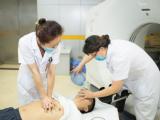Mar 24, 2003 (CIDRAP News) – Tests by the Centers for Disease Control and Prevention (CDC) indicate that a previously unrecognized coronavirus—a virus family associated mainly with the common cold—may be the cause of sudden acute respiratory syndrome (SARS), CDC officials announced today.
The CDC announcement cast doubt on last week's report by the World Health Organization (WHO) that the mysterious disease may be caused by a paramyxovirus, a family associated with measles, mumps, and canine distemper, among other diseases.
CDC Director Julie Gerberding, MD, said the CDC has strong evidence that a coronavirus is the pathogen but stressed that the CDC's conclusion is tentative. "Right now for us, this is a hypothesis," she said at an afternoon news briefing. "It's our leading hypothesis" on the basis of research by leading scientists at CDC and elsewhere. "But we're exercising caution and not being dogmatic here."
The SARS outbreak, centered in Hong Kong, has caused 17 deaths among 458 probable or suspected cases in 14 countries, according to WHO and CDC. Gerberding said there are 39 suspected cases in 18 US states, though no deaths have been reported.
Of the 39 US patients, 32 recently traveled to areas most affected by the outbreak, and the other seven are either household contacts of patients who traveled or are healthcare workers who had close contact with those patients without using respiratory precautions, Gerberding said. "We are not seeing spread in the community at this time," she said.
In a news release, the CDC said two coronaviruses that are known to affect humans cause a third of common colds and also cause "healthcare-associated upper respiratory infections in premature infants."
CDC experts have grown the coronavirus in cultures of tissue samples from SARS patients and have viewed the virus in electron microscope studies, Gerberding said. In addition, polymerase chain reaction (PCR) analyses have identified coronavirus genetic material. "We can see what the virus looks like in tissue culture," she said. "It has a corona, sort of a crown effect, with protein spikes."
The virus has been found in lung tissue and secretions, kidney tissue, and other clinical specimens, Gerberding said. In addition, in three cases serum samples taken early and late in the course of illness have converted from negative to positive for the virus, suggesting that it is the pathogen, she reported. Collectively, the findings constitute "very strong evidence supporting causality," she said.
Gerberding added, "This is not identical to the coronaviruses we've seen in the past, so this may be a new or emerging coronavirus infection." She explained that there are three groups of coronaviruses, but the genetic sequencing studies done so far indicate that this particular coronavirus does not fall precisely into any of them.
There is no "on-the-shelf medication" that is effective against coronaviruses, but the CDC has asked the Department of Defense to rapidly test various antiretroviral drugs to see if they might combat the virus, Gerberding reported.
For now, patients with serious SARS cases are generally getting the recommended treatment for community-acquired pneumonia for their age-group, she said. "The fact that many are improving both here and internationally suggests that many will be able to survive this illness if they have good medical care," she said.
Larry Anderson, MD, chief of the respiratory branch in the CDC's National Center for Infectious Diseases, said some foreign laboratories collaborating with the CDC have also found evidence of coronavirus involvement in SARS. After the CDC used DNA probes, or "primers," to find evidence of the virus, the other labs used the same primers and got positive results, he said.
Gerberding reported that the CDC investigators have not found any evidence of a paramyxovirus in the samples they have analyzed. The samples analyzed so far have come from Hong Kong, Vietnam, and Singapore. "The fact that we've been looking in many patients and looking as aggressively as we know how to look argues against its presence in the patients we've seen," she said.
But she repeatedly said the CDC isn't certain that the coronavirus is the SARS pathogen. "It's one thing to find a virus in a few patients, it's another to find it in the more than 400 people who have been suspected of having this disease," she said.
Further steps needed to confirm the coronavirus hypothesis include further culturing of the virus from appropriate specimens, sequencing of the viral genome, and examining specimens from patients at different stages of the illness, the CDC news release stated.
CDC officials said the SARS investigation has generated unprecedented international collaboration among laboratories. "Labs that would ordinarily be competing with each other are sharing information on a daily basis," said one official at the briefing.
CDC is continuing to warn travelers returning from Hong Kong and other affected areas about the SARS outbreak, said Marty Cetron, MD, of the CDC's division of global migration and quarantine. The agency has not intercepted any sick airline or ship passengers since Mar 21, he said.
See also:
CDC SARS page
http://www.cdc.gov/ncidod/sars/
WHO SARS information
http://www.who.int/csr/sars/en/





















